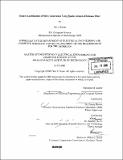Source localization of MEG generation using spatio-temporal Kalman filter
Author(s)
Desai, Neil U
DownloadFull printable version (4.792Mb)
Alternative title
Source localization of magnetoencephalography generation using spatio-temporal Kalman filter
Other Contributors
Massachusetts Institute of Technology. Dept. of Electrical Engineering and Computer Science.
Advisor
Emery Brown and Stephen Burns.
Terms of use
Metadata
Show full item recordAbstract
The inverse problem for magnetoencephalography (MEG) involves estimating the magnitude and location of sources inside the brain that give rise to the magnetic field recorded on the scalp as subjects execute cognitive, motor and/or sensory tasks. Given a forward model which describes how the signals emanate from the brain sources, a standard approach for estimating the MEG sources from scalp measurements is to use regularized least squares approaches such as LORETA, MNE, VARETA. These regularization methods impose a spatial constraint on the MEG inverse solution yet, they do not consider the temporal dynamics inherent to the biophysics of the problem. To address these issues, we present a state-space formulation of the MEG inverse problem by specifying a state equation that describes temporal dynamics of the MEG sources. Using a standard forward model system as the observation equation, we derive spatio-temporal Kalman filter and fixed-interval smoothing algorithms for MEG source localization.To compare the methods analytically, we present a Bayesian derivation of the regularized least squares and Kalman filtering methods. This analysis reveals that the estimates computed from the static methods bias the location of the sources toward zero. We compare the static, Kalman filter and fixed-interval smoothing methods in a simulated study of MEG data designed to emulate somatosensory MEG sources with different signal-to-noise ratios (SNR) and mean offsets. The data were mixtures of sinusoids with SNR ranging from 1 to 10 and mean offset ranging from 0 to 20. With both decrease in SNR and increase in mean offset, the Kalman filter and the fixed interval smoothing methods gave uniformly more accurate estimates of source locations in terms of mean square error. Because the fixed interval smoothing estimates were based on all recorded measurements, they had uniformly lower mean-squared errors than the Kalman estimates. These results suggest that state-space models can offer a more accurate approach to localizing brain sources from MEG recordings and that this approach may enhance appreciably the use of MEG as a non-invasive tool for studying brain function.
Description
Thesis (M. Eng.)--Massachusetts Institute of Technology, Dept. of Electrical Engineering and Computer Science, 2005. Includes bibliographical references (leaf 41).
Date issued
2005Department
Massachusetts Institute of Technology. Department of Electrical Engineering and Computer SciencePublisher
Massachusetts Institute of Technology
Keywords
Electrical Engineering and Computer Science.